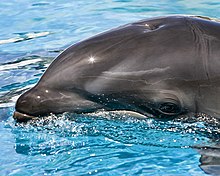Wholphin

A wholphin or wolphin is an extremely rare hybrid born from a mating of a female common bottlenose dolphin (Tursiops truncatus) with a male false killer whale (Pseudorca crassidens). The name implies a hybrid of whale and dolphin, although taxonomically, both are within the "oceanic dolphin" family, which is within the "toothed whale" suborder.[1][2] The first recorded wholphin was born in a Tokyo SeaWorld, but he died after 200 days.[3] The first wholphin in the United States and the first to survive was Kekaimalu, born at Sea Life Park in Hawaii on May 15, 1985; her name means "from the peaceful ocean".[3] Although they have been reported to exist in the wild,[2] only one is currently in captivity, at Sea Life Park in Hawaii.[1]
They are extremely intermediate between both parents. Since a Bottle Nose may have about 88 teeth and a false killer whale has about 44, a wholphin will have 66.[4] They are smaller than a false killer whale but are larger than a normal Bottle Nose.
Kekaimalu proved fertile when she gave birth at a very young age. The calf died after a few days. However, in 1991, Kekaimalu gave birth once again, to daughter Pohaikealoha. For two years, she cared for the calf, but did not nurse it; it was hand-reared by trainers. Pohaikealoha died at age 9. On December 23, 2004, Kekaimalu had her third calf, daughter Kawili Kai, sired by a male bottlenose. This calf did nurse and was very playful. Only months after birth, it was the size of a one-year-old bottlenose dolphin.[1] All three calves were three-quarters bottlenose dolphin and one-quarter false killer whale.[5] Both Kekaimalu and Kawili Kai remain in captivity and are now part of the normal tour at Sea Life Park.
Family tree
Family tree:
| Tanui Hahai (False Killer Whale) ♂ | Punahele (Bottlenose Dolphin) ♀ | ||||||||||||||||||||||||||||||||||||||||
| Bottlenose Dolphin ♂ | Kekaimalu (Wholphin) ♀ | Bottlenose Dolphin ♂ | |||||||||||||||||||||||||||||||||||||||
| Unnamed calf | Pohaikealoha ♀ | Kawili Kai ♀ | |||||||||||||||||||||||||||||||||||||||
References
- ^ a b c Sean B. Carroll (September 13, 2010). "Remarkable creatures". New York Times. Retrieved September 14, 2010.
The first captive wholphin, Kekaimalu, was born on May 15, 1985, to a female bottlenose dolphin named Punahele, who shared a pool with a male false killer whale named Tanui Hahai. The wholphin's size, color and shape are intermediate between the parent species. She has 66 teeth – intermediate between a bottlenose (88 teeth) and false killer whale (44 teeth)
- ^ a b "Whale-dolphin hybrid has baby wholphin". MSNBC. April 15, 2005. Retrieved November 12, 2009.
- ^ a b West, Karen (May 18, 1986). "A Whale? A Dolphin? Yes, It's A Wholphin". Chicago Tribune. Retrieved July 9, 2013. “Born at Sea Life Park on May 15, 1985, Keikaimalu was dubbed a wholphin by Sea Life Park’s training staff.”
- ^ 11 Amazing Hybrid Animals http://www.mnn.com/earth-matters/animals/photos/11-amazing-hybrid-animals/wholphins Mother Nature Network
- ^ (subscription required)%5b%5bCategory:Pages containing links to subscription-only content%5d%5d "Ditching SUVs and Breeding Beefalos". E Magazine. 17 (1). Earth Action Network: 64. January–February 2006. Retrieved May 4, 2013.
{{cite journal}}: Check|url=value (help)
External links
- Waimanalo Hapa Girl Makes 10!, by Keene Rees
- A 'Wholphin' Is Born at CBS News
